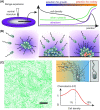Multiple functions of flagellar motility and chemotaxis in bacterial physiology
- PMID: 34227665
- PMCID: PMC8632791
- DOI: 10.1093/femsre/fuab038
Multiple functions of flagellar motility and chemotaxis in bacterial physiology
Abstract
Most swimming bacteria are capable of following gradients of nutrients, signaling molecules and other environmental factors that affect bacterial physiology. This tactic behavior became one of the most-studied model systems for signal transduction and quantitative biology, and underlying molecular mechanisms are well characterized in Escherichia coli and several other model bacteria. In this review, we focus primarily on less understood aspect of bacterial chemotaxis, namely its physiological relevance for individual bacterial cells and for bacterial populations. As evident from multiple recent studies, even for the same bacterial species flagellar motility and chemotaxis might serve multiple roles, depending on the physiological and environmental conditions. Among these, finding sources of nutrients and more generally locating niches that are optimal for growth appear to be one of the major functions of bacterial chemotaxis, which could explain many chemoeffector preferences as well as flagellar gene regulation. Chemotaxis might also generally enhance efficiency of environmental colonization by motile bacteria, which involves intricate interplay between individual and collective behaviors and trade-offs between growth and motility. Finally, motility and chemotaxis play multiple roles in collective behaviors of bacteria including swarming, biofilm formation and autoaggregation, as well as in their interactions with animal and plant hosts.
Keywords: Escherichia coli; chemotaxis; environmental adaptation; motility; physiology.
© The Author(s) 2021. Published by Oxford University Press on behalf of FEMS.
Figures




References
Publication types
MeSH terms
Substances
Grants and funding
LinkOut - more resources
Full Text Sources
Molecular Biology Databases
Research Materials

